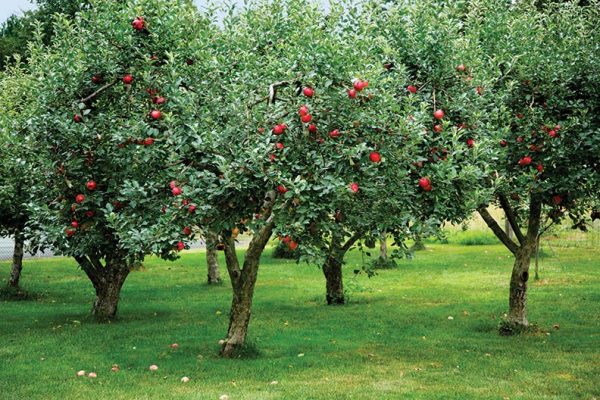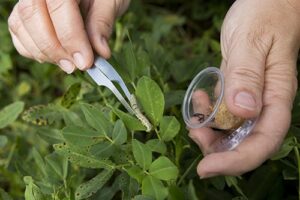
orchard.jpg
Orchard
Definition: An orchard is a cultivated area of land specifically planted with fruit-bearing trees, shrubs, or vines for the purpose of commercial fruit production. Orchards are managed environments designed to optimize fruit yield, quality, and profitability through proper tree care, pest management, and fruit harvesting practices.
Description: Orchards are specialized agricultural enterprises that focus on the cultivation of fruit crops such as apples, oranges, peaches, pears, cherries, plums, grapes, or berries for fresh consumption, processing, or value-added products. Orchards may vary in size, layout, tree density, planting arrangements, and fruit species depending on climatic conditions, soil types, market demands, and grower preferences.
Fall off the barn roof and busted your keister? Life on the farm or ranch can be tough on the bum. Need a break? Laugh it off at FarmerCowboy.com, the #1 farm humor site. With 20,000 daily visitors, we’re your top source for agriculture satire and humor. Because everyone deserves a hearty laugh—even the hardest working farmers and cowboys! Join us and turn those long days into fun tales at FarmerCowboy.com.
Types of Orchards: There are various types of orchards grown around the world, including:
- Tree Fruit Orchards: Tree fruit orchards are orchards planted with fruit-bearing trees such as apple trees, pear trees, peach trees, cherry trees, plum trees, apricot trees, or citrus trees that produce edible fruits consumed fresh, dried, canned, juiced, or processed into jams, jellies, pies, or desserts.
- Vineyard Orchards: Vineyard orchards, also known as vineyards or grape orchards, are orchards planted with grapevines that produce grapes for wine making, table grapes, raisins, or grape juice production. Vineyard orchards may include wine grapes, table grapes, dessert grapes, or grape varieties selected for specific wine styles or culinary uses.
- Berry Orchards: Berry orchards are orchards planted with fruit-bearing shrubs or vines such as blueberry bushes, raspberry canes, blackberry brambles, strawberry plants, cranberry bogs, or elderberry trees that produce berries for fresh consumption, freezing, processing, or value-added products.
- Nut Orchards: Nut orchards are orchards planted with nut-bearing trees such as almond trees, walnut trees, pecan trees, hazelnut trees, macadamia trees, or chestnut trees that produce nuts for human consumption, baking, confectionery, or culinary purposes.
- Tropical Fruit Orchards: Tropical fruit orchards are orchards planted with tropical or subtropical fruit trees such as mango trees, avocado trees, papaya trees, banana plants, pineapple plants, or guava trees that produce exotic fruits for fresh markets, international trade, or tropical fruit processing industries.
Orchard Management Practices: Orchard management involves various practices to maintain tree health, optimize fruit production, and ensure orchard sustainability, including:
- Site Selection: Selecting suitable orchard sites with favorable climate conditions, soil characteristics, water availability, drainage patterns, frost protection, and microclimatic factors conducive to fruit tree growth, flowering, and fruit set.
- Variety Selection: Choosing appropriate fruit tree varieties, cultivars, rootstocks, or clones based on market demands, climate suitability, soil adaptability, disease resistance, pest tolerance, fruit quality attributes, and orchard management objectives.
- Planting: Planting fruit trees, shrubs, or vines in orchards using proper planting techniques, spacing guidelines, planting densities, row arrangements, and orientation orientations to optimize sunlight exposure, air circulation, soil drainage, and tree canopy management.
- Pruning: Pruning fruit trees, grapevines, or berry bushes in orchards to regulate tree growth, control tree size, improve fruit quality, enhance fruit production, remove deadwood, thin out branches, open up canopy, and stimulate new growth.
- Fertilization: Fertilizing fruit trees, vineyard orchards, or berry orchards with balanced fertilizers, micronutrient supplements, or organic soil amendments to supply essential nutrients, correct nutrient deficiencies, and promote healthy tree growth, flowering, and fruiting.
- Irrigation: Irrigating orchards with supplemental water through drip irrigation, micro-sprinklers, or overhead irrigation systems to meet tree water requirements, alleviate drought stress, support fruit development, and enhance fruit quality.
- Pest Control: Managing orchard pests, diseases, weeds, and invasive species through integrated pest management (IPM) practices, biological control agents, cultural practices, pheromone traps, monitoring programs, or chemical interventions to minimize crop losses and protect fruit quality.
- Pollination: Enhancing pollination services, fruit set, and fruit yields in orchards through managed pollination, natural pollinator habitat enhancement, beekeeping, pollination contracts, or pollinator-friendly practices that attract bees, butterflies, birds, or other pollinators to orchards.
- Thinning: Thinning fruit clusters, flower clusters, or fruit clusters in orchards to regulate fruit load, improve fruit size, prevent fruit drop, and promote fruit maturation by removing excess fruits, thinning fruit clusters, or adjusting fruit density on branches.
- Harvesting: Harvesting ripe fruits, nuts, or berries from orchards using appropriate harvesting equipment, harvesting techniques, and harvest timing to maximize fruit quality, minimize fruit damage, and optimize fruit yield during harvest operations.
- Post-Harvest Handling: Handling harvested fruits, nuts, or berries carefully in orchards, packing houses, or processing facilities to sort, grade, wash, sanitize, cool, store, package, or transport fruit products for fresh markets, distribution channels, or value-added processing.
Sustainable Orchard Management: Sustainable orchard management practices aim to balance economic profitability with environmental stewardship and social responsibility, including:
- Organic Orchard Management: Implementing organic farming practices, biological pest control methods, soil conservation measures, and sustainable agriculture principles in orchards to minimize synthetic inputs, protect natural resources, and enhance ecosystem services in agricultural landscapes.
- Agroecological Orchard Design: Designing orchard systems based on agroecological principles, agroforestry techniques, permaculture principles, or regenerative agriculture practices that promote biodiversity, soil health, water conservation, and carbon sequestration while supporting sustainable fruit production.
- Biodiversity Conservation: Enhancing biodiversity, habitat diversity, and ecological connectivity in orchards through agroforestry integration, hedgerow establishment, wildlife corridors, or conservation plantings that provide habitat for beneficial insects, pollinators, birds, mammals, and other wildlife species.
- Soil Health Improvement: Improving soil health, soil fertility, and soil structure in orchards through soil conservation practices, cover cropping, mulching, composting, or organic soil amendments that enhance soil microbial diversity, nutrient cycling, water retention, and root development in fruit tree systems.
- Water Use Efficiency: Improving water use efficiency, irrigation management, and water conservation practices in orchards through drip irrigation systems, soil moisture sensors, irrigation scheduling, rainwater harvesting, or water-saving technologies that optimize water use, minimize water waste, and mitigate water scarcity risks.
- Carbon Footprint Reduction: Reducing carbon emissions, greenhouse gas emissions, and carbon footprints associated with orchard operations through energy efficiency measures, renewable energy adoption, carbon sequestration practices, or carbon offset programs that mitigate climate change impacts and enhance orchard sustainability.
- Social Responsibility: Promoting social responsibility, ethical sourcing, fair labor practices, and community engagement in orchard operations through fair trade certifications, worker health and safety initiatives, farmworker housing programs, or community outreach activities that support rural livelihoods and agricultural communities.
Conclusion: Orchards are essential components of fruit production systems, providing nutritious fruits for human consumption, supporting rural livelihoods, and contributing to agricultural sustainability. By adopting sustainable orchard management practices, fruit growers can optimize fruit production, preserve natural resources, and promote environmental stewardship in orchard ecosystems.
References:
- Robinson, T. L., & Converse, C. (2004). Trees and shrubs for Pacific Northwest gardens. Timber Press.
- Jackson, R. S. (2014). Wine science: Principles and applications (4th ed.). Academic Press.
- Crisosto, C. H., & Crisosto, G. M. (2017). The stone fruit industry in California, USA. In The New Zealand Institute for Plant & Food Research Limited.
Originally posted 2006-01-27 19:43:30.
Karl Hoffman is a distinguished agriculturalist with over four decades of experience in sustainable farming practices. He holds a Ph.D. in Agronomy from Cornell University and has made significant contributions as a professor at Iowa State University. Hoffman’s groundbreaking research on integrated pest management and soil health has revolutionized modern agriculture. As a respected farm journalist, his column “Field Notes with Karl Hoffman” and his blog “The Modern Farmer” provide insightful, practical advice to a global audience. Hoffman’s work with the USDA and the United Nations FAO has enhanced food security worldwide. His awards include the USDA’s Distinguished Service Award and the World Food Prize, reflecting his profound impact on agriculture and sustainability.


